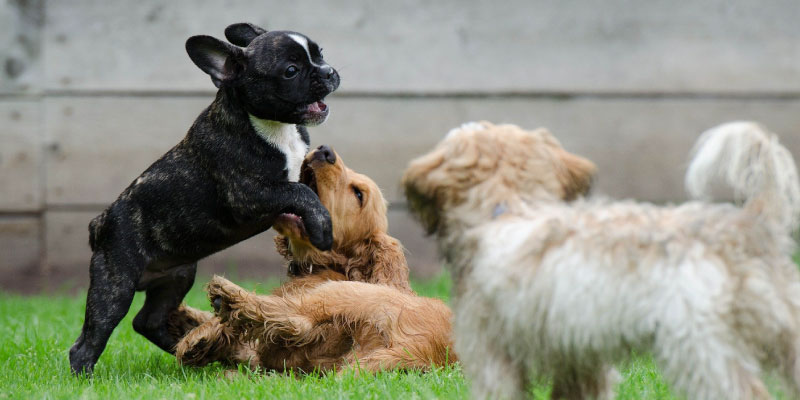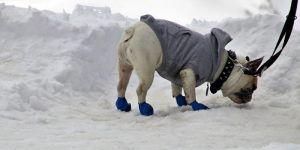Whether you’ve got a new puppy or your usually calm dog has started to get nervous, we’ve got 8 tips to help your dog socialise with other dogs and with humans.
They say a dog is man’s best friend – but this special behaviour is learned, not innate! Just like us, dogs thrive in the company of others, whether it’s humans, other dogs or any other pets in the home.

That’s why it’s so important to give your pup the best start in life and socialise them.
Of course, no two dogs are the same, and everybody’s circumstances are different. You may have had a puppy from birth, or perhaps you inherited a dog or adopted from a care home. The latter can be particularly challenging, especially if yours is a timid dog.
Everything from breed to past experiences and your current home life can make a difference. So, where to start?
Why and When should you socialise a dog?
Ideally, you should begin to socialise a dog with humans and other dogs as young as possible ideally between , though this depends on the situation. Whenever you know that your current circumstances are likely to change, this is when you should focus on your dog’s relationship with others. For example, you might be moving house or having a baby.
Both you and your pet will benefit from an amicable relationship with one another.
Socialisation means helping your canine friends have pleasant interaction with other dogs, adults, vets, children and other animals.
Because the perks of socialising a dog go far beyond the home.
Getting out and about will be easier
If yours is a fearful dog, you may struggle when trying to take part in routine activities like travelling or hitting the local park. Not only should you socialise a dog with other dogs, but with other humans, to make yours and your dog’s life is a happier one.
Introductions to new people or dogs won’t cause a fuss
Perhaps you’ve got a particularly protective dog who doesn’t like intruders! There is no shame in this, but a little social interaction should calm your dog around new people and dogs. It will save hours of embarrassment meeting friends, going to the local park or even just exchanges with delivery men!
You can promote a safe environment
With stories of the dangers of leaving dogs around babies dominating the headlines, there’s a genuine concern for keeping your loved ones safe.
A social dog is a friendly dog, and will not cause harm to young children (or indeed, may want to protect them!). Likewise, they may be less excitable around vulnerable people like the elderly, putting you and your relatives’ minds at rest.
Can I socialise a dog easily?
The short answer is that, generally speaking, yes you can socialise almost any other dog, but it won’t always be easy.
Of course, there is no one proper way to socialise a dog. You need to consider your pet’s age, where you got him/her from, and how you’ll be interacting with other people and pets in your day to day lives. It may be that you are looking to train a guard dog. In which case this blog post is not for you.
The clue in in the title: these friendly tips are all about creating friendly dogs.
From young pups to rescue dogs, here are eight key tips on how to socialise a dog with other dogs and with other humans. Not all the tips will be relevant to yours, but most will be applicable to all.
1. Expose your pup to as many new environments as possible.
Ideally, you should start your puppy training from between three and 12 weeks of age. Think of them like babies, whose minds are like sponges: habits are ingrained early! These new environments include new people, other pets like cats, urban environments, parks, and everyday objects they might come across, like lampposts.
Just try not to do all of this at once – for example, you don’t want to overwhelm your puppy with big crowds of people or throw walk by a motorway on your first walk. Start slow, and build up. If he/she doesn’t like cars, go sit in the boot of your car in a semi-quiet car park and hold them on your lap to give them calm and comfort. If they realise you are calm, they will be calm.
2. Use positive reinforcement with treats.
It’s better to develop a healthy and happy relationship with your pup than scold and punish. You can encourage good behaviour, like calmly introducing your dog to other dogs, with occasional treats. The same goes for new humans as they come through your door. Give them a couple of treats, and get them to go down to the ground and meet your new puppy when they are on all fours.
Not only will this give them a positive experience about meeting new people, but they will not jump up, instead look for a treat. Keep an eye on their daily calorie intake, however, particularly when they’re really little.
3. Don’t play up to it when your dog misbehaves.
A young puppy may get excited and bark when the postman comes to the door. If you respond with theatrics, this will only create a cycle of excitement. Instead, carry on going about your day.
Your dog will soon realise that a postman’s delivery is just one of the many social interactions we face every day.
Remember, positive or negative, your dog loves your attention. So sometimes it best to just ignore the bad behaviour rather than scream or shout. If he bites too hard, yelp in pain, not in anger. This will teach them play fighting needs to be gentle, rather than rough.
4. Consider a dog training school (for all dogs)
This is just as relevant with older dogs – you really can teach them new tricks! If you feel your puppy or older dog is noticeably naughty, or gets anxious around others, it might be time to look up ‘socialise dog training’ or just simple ‘Puppy Schools and Socialisation’.
Among parks and family events, this is one of the great places to socialise a dog. A typical training school will study your dog’s body language and behaviour to determine any problems. It also reinforces good habits through repetition, which you can carry on in the home. A dog trainer can also help with specific behaviour problems.
Whether they hate bicycle, or re particularly protective over one person in the family, sometimes specific problems require specific solutions
At worst, you get easy socialisation – with other puppies of the same age who have lots of energy and are just as new at localisation. If your dog is a little older, they may meet other friendly dogs, or older dogs who can teach them how to behave.
5. Build them up slowly.
For whatever reasons, your dog may simply fear the outside world. For this reason, you should take it on as many walks as possible to accustom your dog to sights, smells and people. We’ve covered this a little bit on point 1, but it’s important to stress: one really bad experience can turn everything sour.
This is no mean feat, so start slowly. For example, ask a friend to bring a friendly dog to your garden. They don’t have to meet, just be near each other. Take a walk up and down the street, then head home. Wander the perimeter of the park and viewing other dogs from afar, then ease your way in closer and closer each time.
6. Proceed with caution.
This is particularly true of many older and rescue dogs – they can react aggressively when they feel threatened, rather than angry. If your older dog tries to attack others, consider a muzzle while you’re still socialising him or her.
After enough walks, your dog will realise that these everyday occurrences are no threat, and you can maybe start taking him out on a leash only. It may be they will always need a muzzle. Older dogs are harder to teach than younger dogs, but remember: if you are calm, they get calm.
7. Don’t pull on your dog or force it. Concentrate on your relationship first.
Again, you need to avoid negative reinforcement like tugging on leads, especially with vulnerable dogs or rescues dogs. Instead, build up a rapport with your new dog by offering it treats, be gentle, and loving.
You need to build up your bond with your new dog in the home, before he trusts you when you are out of the house. Like a child, your new dog needs to know it’s boundaries and rules in the home, making him feel safe and that YOU are in control. If not, (s)he will take control, and that’s how bad behaviour starts.
If it’s nervous about meeting new people, don’t force it. Acclimatise the dog to new environments by going to the park gradually. They will soon come out of its shell with a little time, patience and efforts.
8. Develop a good relationship with your vet
Puppies need vaccinations and regular check ups. Adult dogs require, at minimum, yearly booster shots to keep them healthy. Older and Rescue dogs may need more check-ups than most, so you need to teach your pup that this is a totally normal thing.
Try to choose a vet that welcomes regular visits and offers your dog treats. This is a great way of meeting new people and understanding new environments. It’s all about positive reenforcement.
Tip on how to socialise a rescue dog
This is perhaps the most challenging, but most rewarding, training of all! Signs that a rescue dog isn’t socialised include aggression, hairs standing up, and acting overexcited to the detriment of others. The focus here should be on building trust between you and your new canine friend.
Tip on how to socialise an older dog
With older dogs, the key to socialising is attitude and consistency. You need to reward good habits while building up your dog’s confidence to meet other dogs and people.
They are more set in their ways, and it could be a gradual learnt behaviour that needs gradual re-training. If it’s a particularly violent or traumatic experience that has lead to the nervousness (say another dog attacked them) a dog trainer may be your best bet.
Tip on how to socialise a new puppy
Congratulations – you’ve just got your hands on a new bundle of joy, and you’re responsible for raising it! Like any child, the trick here is to teach them to be happy and confident in a variety of environments. Breed will also come into play here – some breeds will just be more nervous, mouth, or naturally aggressive than others.
The goods news is that because (s)he is a puppy, you can teach them how to be fluent in human behaviour and dog behaviour, as long as you give them a wide of positive experiences as possible. Some to let them experience as soon as possible include:
- Items of clothing that may hide faces or features, such as hoods, jackets, hats and sunglasses.
- Vehicles and noises you’ll find in urban environments, like bicycles, the sound of sirens, of school-grounds.
- How to allow you and those he trust to handle his body, like ears, paws, tails etc… especially usual for visits to the vets and the groomers.
- Different natural environments, from parks, to larger bodies of water such as rivers, lakes and beaches, to forests. The stranger the texture and surfaces, the better. Puppies will trust that what you trust is ok.
- Items you might find around your neighbourhood, such as street signs, buggies, skateboards, benches and scooters.
- Cats and other animals (pigeons, ducks, squirrels)
- Other dogs and humans
With a little patience and a whole load of work, you’ll soon have a nurturing family dog.
The takeaway
Above all, every dog wants to be loved – no matter what its age or past experiences. You can promote a happy environment by sticking to consistent habits, gradually introducing pup to new people, sights, sounds and smells.
Pretty soon you won’t even remember your dog was ever shy or a little bit mouthy. Stick to it, and always ask for professional help if you think you need it. A social dog is one that will leap into your arms after a hard day – what could be better than that?




